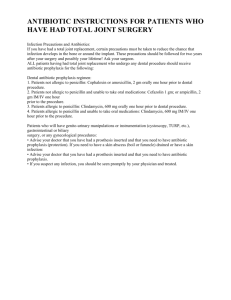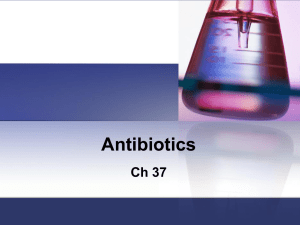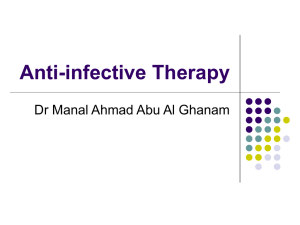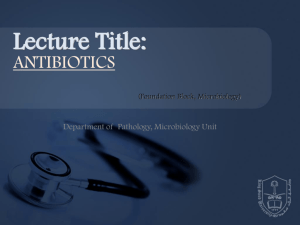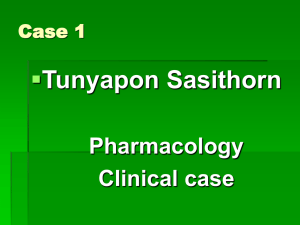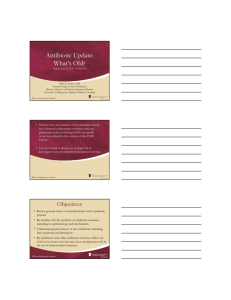Power Point
advertisement
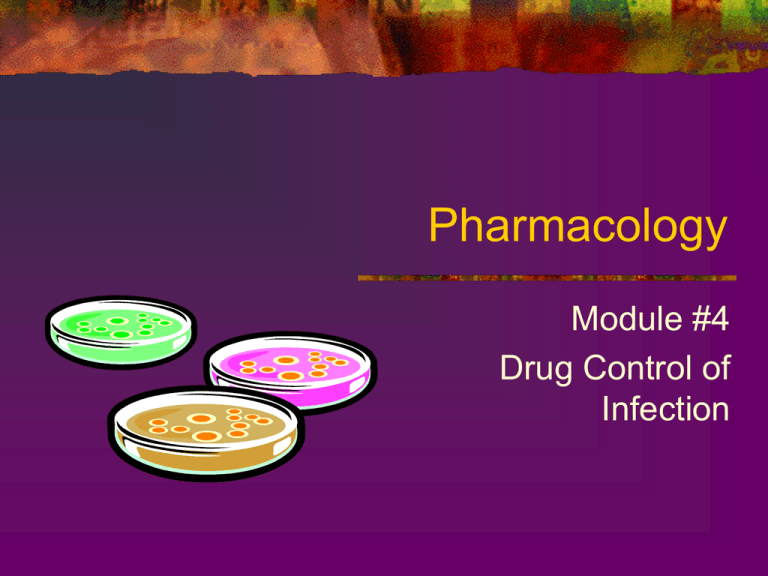
Pharmacology Module #4 Drug Control of Infection Chapter 7 Antiinfective Agents Definitions. Anti- what????? Antiinfective Destroy infections Antimicrobial Antibacterial Destroy or suppress growth of bacteria Chemical produced by a microorganism that can destroy or suppress bacteria Antifungal Antibiotic Destroy or suppress growth of microorganisms Destroys fungi Antiviral Destroys viruses Definitions cont. Bactericidal Ability to kill bacteria Resistance Bacteriostatic Inhibit or retard bacterial growth Infection Invasion of body by pathogenic microorganisms Tissue reaction Ability of bacteria to resist effects of antiinfective agents Spectrum Range of a drug’s activity Narrow or broad More Definitions… Superinfection Synergism Proliferation of microorganisms different from those causing the original infection 2 antibiotics that when combined, produce more effect than expected Antagonism 2 antibiotics that when combined, produce less effect than each agent alone Synergism Vs. Antagonism Synergism 1+ 1= more than 2 DO Example: Bactericidal Bactericidal Note: addition of 2 bacteriostatic agent is merely additive 1+1=2 DO Antagonism 1 + 1= less than 2 DO NOT Example: Bactericidal Bacteriostatic Dental Infection “Evolution” Stage 1- gram +, aerobic microbes Drug of choice Penicillin VK Stage 2- also includes gram – anaerobes (mixed infection) If allergic- erythromycin or clindamycin Pen VK or erythryomycin Stage 3- predominantly anaerobes Metronidazole or clindamycin Antibiotics-To use or not to use?? Overuse of antibiotics is to blame for resistant strains of bacteria Incision and drainage is preferred method of treatment for infection (no prescription of antibacterial drugs) normal immune system localized infection Video- YouTube Clip Resistance https://www.youtube.com/watch?v=AYvX8 tnCM9s Culture and Sensitivity Testing Culturing Growing bacteria in a controlled environment Sensitivity testing Exposing bacteria to certain antiinfective agents to determine sensitivity or resistance Determines appropriate treatment of infections Antimicrobial Use in Dentistry Conditions ANUG periodontal abscess localized juvenile periodontitis adult periodontitis rapidly advancing periodontitis abscess, pericoronitis osteomyelitis aerobes not sensitive to penicillin anaerobes not sensitive to penicillin Which antibiotic to prescribe? ANUG: Periodontal abscess: Pen VK Juvenile periodontitis: Pen VK, Amoxicillin Doxycycline, tetracycline Adult periodontitis: No drug treatment used Which antibiotic to prescribe? Rapidly advancing periodontitis: Soft tissue oral infection: Doxycycline, tetracycline, metronidazole Pen VK, Amoxil Osteomyelitis: Pen VK, Amoxil Which antibiotic to prescribe? Aerobic mixed infection insensitive to penicillin: Amoxicillin with clavulanate Anaerobic mixed infection insensitive to penicillin: Metronidazole, clindamycin Dental Uses of Antibiotics Therapeutic Periodontal disease Soft tissue infections Prophylactic Artificial heart valves History of infective endocarditis Total joint replacement Updated Recommendations American Heart Association website American Dental Association website Drug of choice is Amoxicillin Alternatives: Clindamycin Azithromycin Prophylactic Drug Regimens 1 hour before procedure No allergy Amoxicillin 2000 mg Allergy to penicillins Clindamycin 600 mg Azithromycin 500 mg National Board Question The drug of choice for a person allergic to penicillin for prophylaxis premedication is a. b. c. d. Erythromycin Azithromycin Ampicillin Amoxicillin Antibiotic Prophylaxis for Dental Procedures Recommended: Procedures producing significant bleeding Oral prophylaxis Scaling and root planing Antibiotic Prophylaxis for Dental Procedures Not necessary for: Anesthetic injection through noninfected tissue Taking impressions Taking dental radiographs Sealant placement Fluoride treatments Adverse Reactions Superinfection Potential overgrowth of an organism different from the original infection cause Resistant More common with wide spectrum drugs More common if duration of use is long Allergies Hives to anaphylaxis Penicillins and cephalosporins Adverse Reactions cont. GI tract Stomach pain, increased motility, diarrhea Pseudeomembranous colitis Helps to take with food Pregnancy Limited use- consult obstetrician Pen VK/ erythromycin- OK Tetracyclines- teratogenic Drug Interactions Oral contraceptives May reduce effectiveness of birth control Anticoagulants May increase anticoagulant effect More prone to bleeding/ hemorrhage Other antibiotics Antagonistic effect- decreases effect of both Bacteriostatic and bactericidal National Board Question A two-year-old child has developed an infection requiring an antibiotic. Which of the following would be the least desirable choice? a. b. c. d. Erythromycin Tetracycline Cephaloxin Ampicillin Terms Hypersensitivity Most common drug - penicillin Most common manifestation – rash Cross-hypersensitivity with cephalosporins Penicillinase Bacteria produce this enzyme to break down penicillin Adding clavulanic acid to amoxicillin (Augmentin) prevents penicillinase from breaking it down. Concepts Mechanisms of action of antibiotics: Spectrum Inhibit cell wall synthesis Inhibit protein synthesis Make cell wall more permeable Wide or narrow Bacteriostatic or bactericidal Classifying Anti-Infectives Categorize by: Spectrum or organism affected Broad Narrow Fungus Virus Bacteriostatic or bactericidal Mechanism of action See chart attached to objectives Specific Antibiotics Penicillins Macrolides Tetracyclines Clindamycin Metronidazole Cephalosporins Vancomycin Aminoglycosides Sulfonomides Sulfamethoxazole/ trimethoprim Antituberculosis agents Topicals Penicillin Mechanism of action Spectrum Inhibits cell wall synthesis Bactericidal Narrow Resistance Some bacteria produce penicillinase which breaks down penicillin rendering it ineffective Penicillinase-resistant Penicillins Cloxacillin Dicloxacillin For infections that are penicillinaseproducing staphylococci only More side effects Not for people allergic to penicillin Ampicillins Examples: ampicillin, amoxicillin (Augmentin, Amoxil, Trimox) Not penicillinase resistant (Augmentin is) Gram + cocci and enterococci Better absorbed, requires less frequent dosing, absorption not impaired by food May cause allergic reactions Macrolides Examples: erythromycin, clarithromycin, azithromycin Mechanism of action Inhibits protein synthesis Bacteriostatic Spectrum Narrow Macrolides cont. Adverse reactions: GI upset Jaundice Uses: Patients allergic to penicillin Effective against aerobes Tetracyclines Examples: tetracycline, doxycycline Mechanism of action Inhibits protein synthesis Bacteriostatic Spectrum Wide Aerobes and anaerobes Adverse Effects of Tetracycline GI Nausea, vomiting, xerostomia, superinfectioncandiasis Teeth and bones Permanent tooth discoloration Incorporated into tooth structure Do not give during pregnancy or children less than 9 years old Enamel hypoplasia Clindamycin Mechanism of action Spectrum Inhibits protein synthesis Bacteriostatic Wide Uses Gram + and anaerobes Clindamycin Adverse Effects GI Superinfection Usual- nausea, vomiting, diarrhea, cramping Severe- pseudomembranous colitis (persistent diarrhea and passage of blood and mucous) can be fatal Candidiasis Allergy Metronidazole Mechanism of action Spectrum Bacteriocidal Anaerobes Resistance is rare Uses Treatment of NUG Metronidazole Drug Interactions Alcohol Causes headache, nausea, vomiting, cramps Disulfiram= Antabuse reaction Cephalosporins Mechanism of action Spectrum Inhibits cell wall synthesis Bactericidal Wide Uses Infections resistant to penicillin Gram – organisms Vancomycin Spectrum Narrow Uses Non-dental Eradicate bacteria in GI tract Aminoglycosides Spectrum Wide Adverse effects Ototoxicity Toxic to 8th cranial nerve- can lead to auditory and vestibular (inner ear) disturbances Sulfonamides Mechanism of action Spectrum Wide Uses Interferes with folate metabolism Non-dental, ear infections Adverse effects Renal crystallization- drink plenty of water Sulfamethoxazole/ Trimethoprim Combination antimicrobial drug Bactrim Uses Ear infections in children Antituberculosis Agents Tuberculosis (TB) Can be contracted in dental setting Drugs used for treatment: Isoniazid Rifampin Pyrainamide Ethambutol NOTE: Used together b/c of resistance Topical Antibiotics Applied to the skin Example: Neosporin Neomycin, polymyxin, and bacitracin Review of Mechanisms of Action Bactericidal or bacteriostatic Inhibit bacterial cell wall synthesis Inhibit bacterial protein synthesis bacteriostatic Inhibit nucleic acid synthesis bactericidal RNA & DNA Interfere with folate metabolism anti-metabolites Claire Cranberry No Allergy to penicillin Classifications candadiasis tetracycline – antibiotic Sudafed – alpha adrenergic agonist tetracycline & sudafed both could be involved nystatin or clotrimazole clindamycin 600 mg (3 tabs) 1 h before appt. NSAID? Review Which antibiotic causes damage to the 8th cranial nerve? aminoglycocides Review Which antibiotic causes pseudomembranous colitits? Clindamycin Which antibiotic causes a disulfram-like reaction? metronidazole Review Name 4 broad spectrum antibacterial agents. Aminoglycocides Cephalosporin Clindamycin Sulfonamides Tetracycline Review Which antibiotic has a crosshypersensitivity with penicillin? Cephalosporin Matching- Method of action Inhibit cell wall synthesis Inhibit protein synthesis Interfere with folate metabolism Tetracycline Erythromycin Penicillin Cephalosporin Sulfonamide Amoxicillin Chapter 8 Antifungal and Antiviral Agents Antifungal Agents Used to treat fungal infections Example: candidiasis Nystatin and Clotrimazole Mechanism of action Nystatin Alteration of cell membrane permeability Available as a suspension, lozenge, or cream Clotrimazole Available as a troche or cream Nystatin and Clotrimazole Directions for patient: Suspension Swish, swirl, spit or swallow 5 ml four x daily Should remain in mouth for 2 mins. Troches/ lozenges Dissolve in mouth slowly Take all of the medication Amphotericin B Uses severe fungal infections- systemic Adverse reactions Hypokalemia, headache, chills, fever, malaise, muscle and joint pain, gastric complaints, nephrotoxicity Antiviral Agents Used to treat viral infections Examples: HIV, herpes Treatment of Herpes Drugs Adverse reactions Acyclovir, docosanol, penciclovir Burning skin, headache, dizziness, GI upset Uses Genital and oral herpetic lesions Treatment of HIV Nucleoside analogs Zidovudine (AZT, ZDV) Terminates the synthesis of viral DNA Protease inhibitors Indinavir Prevent maturation of HIV-infected cells Chapter 13 Oral Conditions and Their Treatment Herpes Simplex Labialis AKA cold sore, fever blister Antiviral agents Acyclovir Valacyclovir Penicyclovir Candidiasis Antifungal agents Nystatin suspension Clotrimazole troches/ lozenges Pericornitis/ Alveolar Osteitis Treatment: Rinsing with saline water Debridement Pack placement Analgesics Supportive therapy If infection present, prescribe antibiotics
